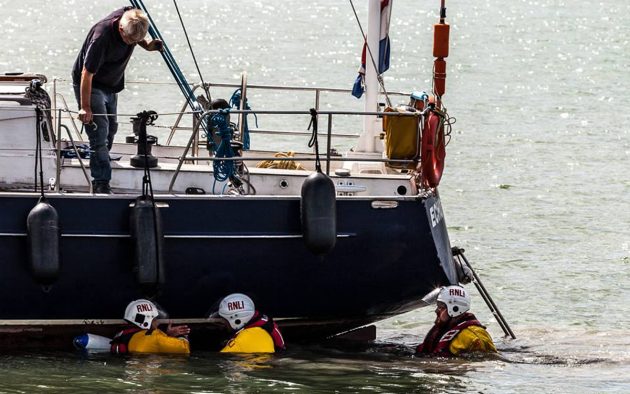Underwater snags: How to escape when your yacht is caught in debris
Pro sailor Pip Hare gives her top tips on how to escape from all sorts of underwater snags, from Sargasso weed to spinnaker debris Whether it’s a fishing pot, long tendrils of Sargasso weed or your own spinnaker sheets, getting stuff wrapped around keels, rudders and propellers is an occurrence every sailor will have to deal with at least once in a lifetime afloat.
Whether it’s a fishing pot, long tendrils of Sargasso weed or your own spinnaker sheets, getting stuff wrapped around keels, rudders and propellers is an occurrence every sailor will have to deal with at least once in a lifetime afloat.
The severity of this problem can range from annoying to incapacitating, and how you deal with the situation will differ accordingly. There is no definitive guide to sorting out all possible underwater snags, but here are some thoughts from my own sometimes bitter experience.
Avoid and identify
Keep a look out for large patches of weed as well as fixed obstacles, especially when racing. If communicating to the helm about an obstacle give precise information – either position relative to port or starboard bow, or degrees and direction to steer for avoiding action. Remember to allow for the tide on fixed objects.At night ensure instruments are dimmed to the minimum setting; plotters in particular can ruin your night vision. Try covering them when they are not needed.If something does end up tangled under your boat, getting sight of it is going to be the best start to finding a solution. Offshore race boats will often having small viewing ports in the bottom of the boat; those with larger budgets fit endoscopes.However, now there is a wide range of small, waterproof HD cameras on the market, a more accessible solution is to tape a camera to a spare batten or boathook, then dunk it over the side, taking video or photographs. If visibility is poor this may not work, but you will be surprised how much you can see during the day with a long batten, even if the water is murky.
Sailing backwards
Sailing backwards is a great way to clear weed and also to unhook fishing pots from the front of keels. Roll or drop headsails to avoid them backing, then release the mainsheet – ensuring plenty of slack in the falls. Throw the helm over and hold your boat head to wind. In lighter conditions an experienced crew can back the main by pushing the boom outboard.Keep the bow pointing exactly into the wind as your way comes off. As the boat starts gaining backwards momentum remember to reverse your steering and hang onto the helm. Look forward of the keel to see what floats up.

In reality you may only be able to get going backwards around 50 per cent of the time, and this is easier to achieve in lighter displacement boats. However, just stopping in the water may be enough to dislodge weed and if you are certain there is nothing around your propeller, try motoring in reverse.
Tools for the job
To clear weed without stopping, try using a flossing line. This is a just a rope, or rope jacket, with overhand (stopper) knots tied down its length at regular intervals. Hang the rope under the bow with a crew member on each end and then walk backwards down the deck, while also pulling the rope back and forth under the boat in a sawing motion.
For transom-hung rudders a weed stick can be made using a piece of curved wire on a long batten or carbon pole. The wire hooks onto the leading edge of the rudder and is kept in place by the passing water, enabling the user to push any weed down and off the tip of the rudder.
Rope cutters are available for both shaft driven and saildrive motors, but they do impact sailing performance. A bread knife strapped to a boathook can also be surprisingly effective.
Prop wraps
If you’re quick enough to stop a shaft driven motor and can get hold of the offending rope, it may be possible to manually unwind a light wrap. Have one person on deck holding tension on the rope while another is below turning the prop shaft by hand. If the rope gets tighter rotate the shaft in the opposite direction. It is worth trying this on every occasion.
For saildrives, tighter wraps or when the source of the wrap cannot be seen, diving under the boat may be the only option. This should not be undertaken lightly. Some key things to consider when making that decision are:
- Inspection – try to view the problem before sending someone into the water.
- Location – find somewhere as sheltered as possible and out of fast-flowing currents Timing – can you wait for daylight or calmer conditions? Can you possibly sail to safety without the engine?
- Equipment – carry a good quality snorkel, mask and, if possible, wetsuit. Always wear gloves to protect hands from scratches. Use a waterproof torch in poor visibility and a good quality knife with serrated blade. Single use diving cylinders can be great for longer jobs, but the diver must have previous experience of using this type of equipment. It’s worth reiterating that a good mask is essential.
- Diver – should be practised at using the kit and be a confident swimmer.
- Safety – remove keys from the engine, heel the boat to get your propeller closer to the surface, use a recovery rope around the diver’s waist, and do not allow the diver to get excessively cold. Beware of diving in conditions where the boat is slamming to avoid possible head injuries.
- source:https://www.yachtingworld.com/
be able to get going backwards around 50 per cent of the time, and this is easier to achieve in lighter displacement boats. However, just stopping in the water may be enough to dislodge weed and if you are certain there is nothing around your propeller, try motoring in reverse.source:https://www.y




